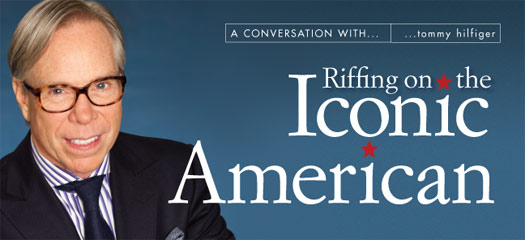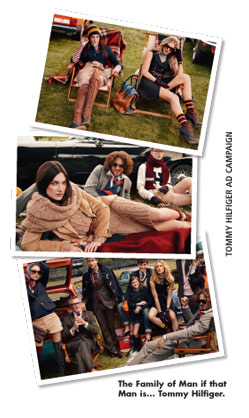
Photographed by Stephen Sullivan
By Patrisha Zabrycki
I was five years old, strolling through the aisles at Macy’s with my Mom, when amid the drabness of corporately diluted earth tones and jeans washed without a thread of conviction, I spotted something that really stood out: a button up shirt, blue as the sky, with the tiniest emblem of red, white and blue. I begged my Mom to buy it for my Dad.
THAT was my first encounter with what Tommy Hilfiger calls “fresh yet familiar.” A crisp twist on the classically American preppy style. Hilfiger launched his now famous brand in 1985, which I’ll hesitantly reveal, was the year this writer was born. As I prepared to conduct this interview with “Tommy” I was more than a little aware I literally have been familiar with his work my entire life.
 The Hilfiger brand has a way of reaching across generations and cultures with its expertly crafted line of clothing, shoes, accessories, house wares and… eyewear. Capturing and succeeding in the global market is central to Hilfiger. “For me it’s all about pop culture. It’s about fashion, art, music, entertainment and how it all blends together, and how it all really makes the world go round. Because in Japan pop culture is as important as it is in London or in New York, or in Minneapolis or Miami, so for us to embrace music, sports, entertainment, Hollywood is very important to keep the brand fresh, cool, relevant and timely.”
The Hilfiger brand has a way of reaching across generations and cultures with its expertly crafted line of clothing, shoes, accessories, house wares and… eyewear. Capturing and succeeding in the global market is central to Hilfiger. “For me it’s all about pop culture. It’s about fashion, art, music, entertainment and how it all blends together, and how it all really makes the world go round. Because in Japan pop culture is as important as it is in London or in New York, or in Minneapolis or Miami, so for us to embrace music, sports, entertainment, Hollywood is very important to keep the brand fresh, cool, relevant and timely.”
But while many designers might keep an eye on pop culture, Hilfiger makes it central to his products’ strategy. As a huge supporter of the pop culture and entertainment industries he is always close to his consumers. And while he has unique gifts as a designer and entrepreneur, his biggest talent is an instinct for knowing what fashion lovers all over the world will respond to—functionally stylish clothes and accessories that star on the tennis court and in the boardroom.
Much consideration is paid to the design and marketing of his new eyewear collection. Having recently signed on with Sàfilo Group for the manufacturing and distribution of Tommy Hilfiger eyewear, he is confident in the success founded on the new partnership. “We feel Sàfilo is the best in the business. They understand us very well. They know what they’re doing in terms of manufacturing and collaborating with us on design. But also with distribution, we have a great reach with them. Having a partner like Sàfilo positions us very well in the market.” A market that is in love with the preppy, all-American designs that the Hilfiger brand has successfully crafted for years. His style has stayed close to its roots: plaids, tennis whites, chinos, pleated patterns and color-blocked rugby shirts. It’s an all-American sensibility with a pinch of ‘tude. Hilfiger illustrates this point: “Every season I seek to set trends while staying true to the signature design sensibilities that Tommy Hilfiger has embraced for the last 25 years. I have kept true to my roots of American classics while adding a fresh twist each season. I’ve added prints to basic silhouettes, reshaped the classic polo, played with new colors, and added a heel to the classic boat shoe. These elements inject a sense of newness that keeps the collections at the forefront of cool, American style.”
As I watched our cover shoot, I noticed Hilfiger stepping back between shots to make sure the models had the right look. Even among the high-strung droves of PR people, hairstylists and makeup artists, Hilfiger—ever the designer, ever the stylist—reached over to the models and began patterning the pleats of the model’s lily-white tennis skirt and smoothing the lapels on the male model’s piqued polo. In fact, the longer I was around Hilfiger, the easier it was to see the care, the detail and quality he pours into all aspects of his iconic lifestyle brand, and the new Tommy Hilfiger collection is no exception. Every detail is scrutinized. From the selection of color on the 1985 25th Anniversary style—a color blocked zyl sunglass, striated in a patriotic red, white and blue—down to the gold hued temple details on the tortoise ophthalmics that Hilfiger dons.
As Hilfiger and I sat courtside at the Manhattan Plaza Racquet Club in canvas deck chairs, he took me through a few pieces of his collection starting with the 1985 25th Anniversary sunglass. “These have the red, white and blue enamel, but they remind me of old Hollywood and they’re also a bit sporty.” Then, picking up a 1970s-inspired sunglass, “They’re oversized but not dramatically oversized and we think that this shape in many different colors is a must-have. And if you look at it in red with the white inlay, we think it’s pretty fantastic—gold accents on the temples,” pointing to the golden Hilfiger insignia and commenting that it maintains a subtle branding reference—not too over done, just played down enough.
Fingering over his mostly zyl frames, Hilfiger says, “We have a big following in Europe and all over the world, anything with a little bit of a twist on it is really important to us. We’re very preppy all-American. And these [frames] can go from day into evening; they can be dressed up or dressed down.”
 Showing me the aviators, he continues: “On the men’s side they are really iconic… red, white, black or red, white, blue and sporty but at the same time a unique signature.”
Showing me the aviators, he continues: “On the men’s side they are really iconic… red, white, black or red, white, blue and sporty but at the same time a unique signature.”
Referring to the frames he is wearing, “This is a real classic, ivy league, collegiate…Vintage but also very fresh and familiar, which we like with everything we do.” Hilfiger asks one of his associates for his own frames, puts them on and quips, “Oh now I can see you!”
Once clad in his Rx frames, Hilfiger leans in holding the tortoise ophthalmics up to the light, “I like anything tortoise. I like the dark tortoise, of course I like the light tortoise. I like when you hold them up to the light and you can see through them. And I love the fact that the quality is there. It’s great quality.”
As he treated each frame like he was showing me the world’s finest eyewear, one really got a sense of how much sincere thought and detail goes into a Hilfiger design. Even the way a patterned zyl catches the light is a consideration.
I remarked that I too am a lover of anything tortoise, to which he replied, “Yes, it’s very collegiate; it’s preppy, very all-American, very Ivy League, very old world and it can go with ANYone, ANYtime, ANYwhere.”
As chat time with Hilfiger drew to a close, I began to see how someone who has been at the top of the fashion world so long, who has seen all manners of fads and fashion movements oscillate in and out of favor with consumers, views the difference between a trend and style. It is a line that as a fashion editor I am constantly straddling—embracing the trendy yet discerning if a fad has the longevity to enter the canon of timeless style. Hilfiger remarks, “Style is forever and trends come and go, and I think fashion is bent on trends and sort of makes the headlines. But style is something that you either have or don’t have. You can buy it but you cannot necessarily own it. I think a lot of people are just born with it, the way they put themselves together, the way they eat, where they go and where they live—it all has to do with a certain style and a certain attitude. Sometimes you can look at someone and think immediately—that person has style—just by the way they carry themselves, they could be in jeans and a t-shirt. Something that is not anything you can put your finger on is about style.” Wearing a bespoke tailored suit, dark hued P3 frames and with his delightfully fitted, plaid coat draped over his arm ready for a swift and stealth-like exit, Hilfiger embodies this specifically unspecific quality. In a swift instant, he went back out to the windy daybreak streets of New York, living his brand detailed down to the last perfectly preppy thread. ■










